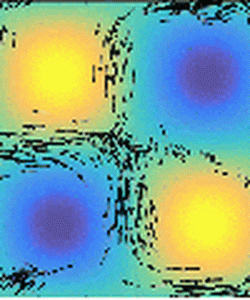New model sheds light on 'flocking' behaviour

Understanding how turbulence can alter the shape and course of a flock of birds, a swarm of insects or even an algal bloom could help us to better predict their impact on the environment.
Animal groups frequently exhibit complex, coordinated behaviour arising from social interactions among individuals. This collective motion offers some of the most spectacular displays in the natural world.
Now mathematicians at Newcastle University have investigated for the first time how the surrounding fluid environment – such as air and water - can affect the shape of a model flock.
Published today in the academic journal Physical Review E, the research calculates the interaction between vortical flow and 'flocks' and describes how vortices - the building blocks of turbulence - affect the shape of the flock.
Shedding light on a phenomenon which was first described in the 16th century by Leonardo da Vinci and has intrigued observers ever since, research author Dr Andrew Baggaley says the new mathematical model could be a first step towards helping us better predict, for example, the spread of disease by insects.
"It is natural to think that organisms which display what we term as flocking behaviour will naturally tend to clump together to form a sphere because this is the shape that offers the greatest protection to the greatest number," explains Dr Andrew Baggaley, based in the School of Maths and Statistics at Newcastle University.
"What this paper explains is how the underlying turbulence – the invisible swirls formed from lots and lots of mini tornadoes – can destabilize these flocks, pushing the individuals to the edges of the vortices, and in some cases, the course of direction; as the flow increases, so the effect on the flock becomes more pronounced.
"By understanding this, it could help us to more accurately predict where an algal bloom might occur, for example, or how a disease might spread if it is carried by insects."
The paper shows how the behaviour of these larger organisms mimics the way in which particles behave at a molecular level, the particles being pushed away from the centre and becoming clustered around the edge of the vortex.
"A tornado is an extreme example but we can all visualize the start of the Wizard of Oz where Dorothy's house and everything else is spinning around the edges. A smoke ring is similar but on a less dramatic scale.
"And what we are demonstrating is surprisingly strong effect of the underlying, swirling flow of fluids at a macro scale."
A mathematical equation which quantifies the shape of a flock is expressed as: F = (P2 - 4πS)/( P2+4πS), this could also be used to understand other types of 'clustering' behaviour, says Dr Baggaley.
"For example, a similar model to the one used here has been used to model the motion of people in a mosh pits at a heavy metal concert.
"While the triggers are different – and clearly the turbulent flow in the air is not going to change the direction of a stampeding crowd – the mathematical principals are the same."
More information: "Model flocks in a steady vortical flow." journals.aps.org/pre/accepted/ … e3766925150bfc341695
Journal information: Physical Review E
Provided by Newcastle University

















